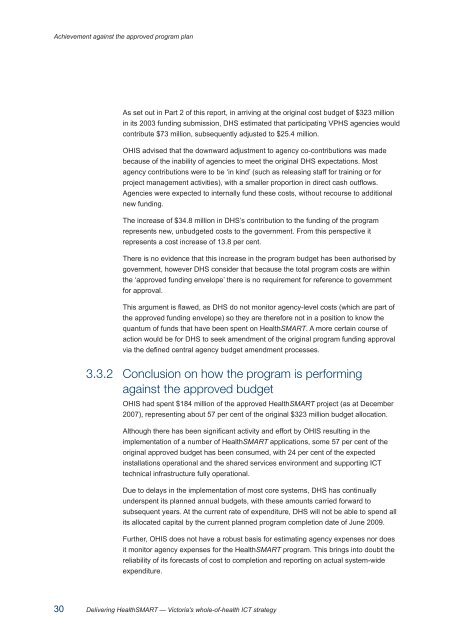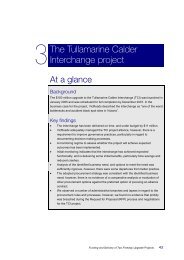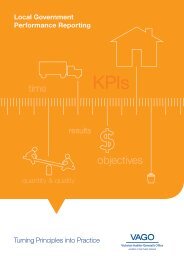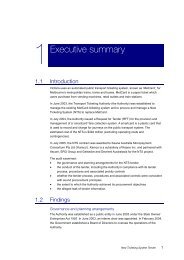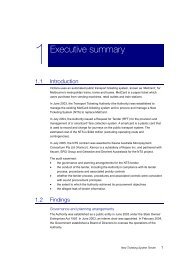Delivering HealthSmart Report - VAGO
Delivering HealthSmart Report - VAGO
Delivering HealthSmart Report - VAGO
Create successful ePaper yourself
Turn your PDF publications into a flip-book with our unique Google optimized e-Paper software.
Achievement against the approved program plan<br />
As set out in Part 2 of this report, in arriving at the original cost budget of $323 million<br />
in its 2003 funding submission, DHS estimated that participating VPHS agencies would<br />
contribute $73 million, subsequently adjusted to $25.4 million.<br />
OHIS advised that the downward adjustment to agency co-contributions was made<br />
because of the inability of agencies to meet the original DHS expectations. Most<br />
agency contributions were to be ‘in kind’ (such as releasing staff for training or for<br />
project management activities), with a smaller proportion in direct cash outflows.<br />
Agencies were expected to internally fund these costs, without recourse to additional<br />
new funding.<br />
The increase of $34.8 million in DHS’s contribution to the funding of the program<br />
represents new, unbudgeted costs to the government. From this perspective it<br />
represents a cost increase of 13.8 per cent.<br />
There is no evidence that this increase in the program budget has been authorised by<br />
government, however DHS consider that because the total program costs are within<br />
the ‘approved funding envelope’ there is no requirement for reference to government<br />
for approval.<br />
This argument is flawed, as DHS do not monitor agency-level costs (which are part of<br />
the approved funding envelope) so they are therefore not in a position to know the<br />
quantum of funds that have been spent on HealthSMART. A more certain course of<br />
action would be for DHS to seek amendment of the original program funding approval<br />
via the defined central agency budget amendment processes.<br />
3.3.2 Conclusion on how the program is performing<br />
against the approved budget<br />
OHIS had spent $184 million of the approved HealthSMART project (as at December<br />
2007), representing about 57 per cent of the original $323 million budget allocation.<br />
Although there has been significant activity and effort by OHIS resulting in the<br />
implementation of a number of HealthSMART applications, some 57 per cent of the<br />
original approved budget has been consumed, with 24 per cent of the expected<br />
installations operational and the shared services environment and supporting ICT<br />
technical infrastructure fully operational.<br />
Due to delays in the implementation of most core systems, DHS has continually<br />
underspent its planned annual budgets, with these amounts carried forward to<br />
subsequent years. At the current rate of expenditure, DHS will not be able to spend all<br />
its allocated capital by the current planned program completion date of June 2009.<br />
Further, OHIS does not have a robust basis for estimating agency expenses nor does<br />
it monitor agency expenses for the HealthSMART program. This brings into doubt the<br />
reliability of its forecasts of cost to completion and reporting on actual system-wide<br />
expenditure.<br />
30 <strong>Delivering</strong> HealthSMART — Victoria's whole-of-health ICT strategy


